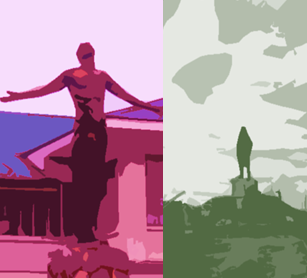 MANILA: Many Philippine nationalists don't realize this, but the US conquered us Filipinos with American English 100 years ago; today, you may not have noticed, but this puny country of ours already has begun conquering the world with American English. In fact, the conquest started 13 years ago, and it's global in scale. Will Manuel Luis Quezon turn in his grave?
MANILA: Many Philippine nationalists don't realize this, but the US conquered us Filipinos with American English 100 years ago; today, you may not have noticed, but this puny country of ours already has begun conquering the world with American English. In fact, the conquest started 13 years ago, and it's global in scale. Will Manuel Luis Quezon turn in his grave?
Thinking local and acting local, Pinoy nationalists have always insisted on a Tagalog-based national language, and I have always insisted on an English-based national language for the Philippines. More than 50 years ago, in the late 1960s, during those radical years at the University of the Philippines, on campus my fellow alumni activists would speak in Tagalog and I would speak in English. I always felt at ease reading, writing and speaking in English, since high school. I wasn't thinking of colonialism, only of communication.
Now I'm thinking of call centers in the Philippines where your English is as good as cash. We learn from Philippine pioneer American Andy Sarakinis that it was only 13 years ago when the call center industry in the Philippines was yet in its infancy (Camille Bersola, "An interview with C3 executive," 2 March 2014, Philippine Star print edition, page C1; I can't find it in the online edition). The same was true of the business process outsourcing (BPO). After the year 2000, what happened over the years was phenomenal, according to Andy. It wasn't so much of a leap of faith but so much more of leaps and bounds.
Fast forward. In 2011, the New York Times called Manila the "New Capital of Call Centers" (Vikas Bajaj, 25 November 2011, nytimes.com). That year, the Philippines overtook India as the call center capital of the world. Vikas says:
Over the last several years, a quiet revolution has been reshaping the call center business: the rise of the Philippines, a former United States colony that has a large population of young people who speak lightly accented English and, unlike many Indians, are steeped in American culture.
As of 2011, the number of call center agents is already 400,000 Filipinos in the Philippines and only 350,000 Indians in India. Note that India has 10 times the population of the Philippines, which means that all the world loves American English – and Filipino call center agents. And Pinoys typically earn more than their Indian counterparts at the entry level, $300 a month vs $250. As of December 2013, the suggested rates per month are $450-$750 for General Virtual Assistant, $400-$600 for Article & Content Writer, $600-$800 for SEO & Web Marketer, and $600-$1,400 for Web Developer (Chris Ducker, chrisducker.com).
The world is paying Filipinos to work for them because of their American English. Isn't this taking advantage of colonialismthat you can't do anything about anymore anyway? You cannot rewrite history, but you can write it.
I was surfing Facebook the other day and when I came to the webpage of my son Jomar, who has embarked on a journey of training Virtual Assistants anywhere they are in the Philippines as long as they are connected to the Internet in their own homes, a thought flashed through my head:
Virtual Assistants are the reverse overseas Filipino workers that we can make millions of to make billions for the country.
Jomar has been successful in raising local-global VAs and continues to do so. While Pinoy OFWs continue to multiply, I believe there are a million more chances for Pinoys to land a contract with a foreign institution or individual because of our well-known talent in American English, competent use of information technologies, and knowledgeable use of social media.
Why do people hire Virtual Assistants? A Virtual Assistant is an independent office support who works via the Internet and cell phone for someone, say in the United States, but is based in his own home, say in the Philippines. The magic of modern media. Virtual Assistants save employers much money. Since the VAs are independent contractors, for the contracting company, there are no employee-related taxes, insurance or benefits; there are no office spaces to create, and no equipment or supplies to make available.
As a VA, you can be an Executive Assistant, Office Manager, Supervisor, Secretary, Legal Assistant, Paralegal, Legal Secretary, Real Estate Assistant, Information Technology Assistant, Online Personal Assistant, Online Sales Assistant, Virtual Webmaster Assistant, Virtual Marketing Assistant, Virtual Content Writing Assistant etc. In other words, a VA provides support to any number of clients in terms of the following services: administrative, technical and creative.
There is the International Virtual Assistants Association based in the United States that has a membership of 600 VAs in 16 countries (ivaa.org), assisting the assistants. Virtual Assistants were once referred to as Telecommuters, says Jodi Diehl, past president of IVAA. According to her:
Originally telecommuting was reserved for those who were administrative in nature. With advancements in technology, the Virtual Assistant Industry now consists of enterprising individuals, many of whom have elected to leave corporate positions in order to provide highly skilled services virtually, as entrepreneurs.
What are the advantages to companies when they hire Virtual Assistants?
In addition to eliminating the taxes, vacations, insurance and other employee-related costs, the Virtual Assistant Industry offers the corporate world access to an incredible pool of specialized talent previously unobtainable. Technology has enabled this fantastically flexible and beneficial new way to do business quickly, efficiently and economically.
And who are those who engage VAs for their services? There are real estate agents, authors, photographers, national speakers, financial advisors, coaches, corporate and industrial institutions. "VA clients are companies or individuals," says Jodi, "who understand the importance and enjoy the advantages of having experts in their team."
Being the unbeatable #1 in the field of virtual assistance, the Philippines should take advantage of its supremacy. Now then, I recommend that the Philippine government provide at least 50% of the budget it allots for OFWs for our resident Reverse OFWs, to help the poor but deserving Pinoys put up their own Internet-based home office and even pay for their VA training.
To those who have doubts, why should the whole world hire Virtual Assistants from the Philippines? Let's have it from Owen McGab Enaohwo (hireyourvirtualassistant.com):
Hiring a Virtual Assistant from the Philippines makes perfect sense since Filipinos are hard workers and have an impeccable work ethic compared to other international VAs. You can find quality but less expensive workforce from the Philippines. Aside from skills, they value competence and are well versed in both spoken and written English.
Rian Estefan says "The Philippines (is) the best place to look for a Virtual Assistant" (businessroot, wordpress.com):
Hiring a virtual assistant from the Philippines is the perfect solution to all your virtual assistant needs. Filipinos are renowned worldwide for being hard workers with the right work and personal ethics. They are also well versed in both written and oral English.
In the years to come, the Pinoy VAs will then be those who will help the Philippines make colonies of all the world using the mighty sword called American English. This tiny colony of ours will then be the colonizer of the business world, and much loved.
Filipino nationalists from the bottom to the top, wake up from your Quezonian slumber!




















